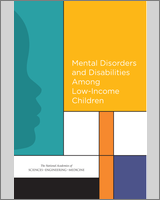NCBI Bookshelf. A service of the National Library of Medicine, National Institutes of Health.
Children living in poverty are more likely to have mental health problems, and their conditions are more likely to be severe. Of the approximately 1.3 million children who were recipients of Supplemental Security Income (SSI) disability benefits in 2013, about 50% were disabled primarily due to a mental disorder. An increase in the number of children who are recipients of SSI benefits due to mental disorders has been observed through several decades of the program beginning in 1985 and continuing through 2010. Nevertheless, less than 1% of children in the United States are recipients of SSI disability benefits for a mental disorder.
At the request of the Social Security Administration, Mental Disorders and Disability Among Low-Income Children compares national trends in the number of children with mental disorders with the trends in the number of children receiving benefits from the SSI program, and describes the possible factors that may contribute to any differences between the two groups. This report provides an overview of the current status of the diagnosis and treatment of mental disorders, and the levels of impairment in the U.S. population under age 18. The report focuses on 6 mental disorders, chosen due to their prevalence and the severity of disability attributed to those disorders within the SSI disability program: attention-deficit/hyperactivity disorder, oppositional defiant disorder/conduct disorder, autism spectrum disorder, intellectual disability, learning disabilities, and mood disorders. While this report is not a comprehensive discussion of these disorders, Mental Disorders and Disability Among Low-Income Children provides the best currently available information regarding demographics, diagnosis, treatment, and expectations for the disorder time course - both the natural course and under treatment.
Contents
- The National Academies of SCIENCES • ENGINEERING • MEDICINE
- COMMITTEE TO EVALUATE THE SUPPLEMENTAL SECURITY INCOME DISABILITY PROGRAM FOR CHILDREN WITH MENTAL DISORDERS
- Reviewers
- Preface
- Acknowledgments
- Acronyms and Abbreviations
- Summary
- NATIONAL TRENDS IN THE SSI PROGRAM FOR CHILDREN WITH DISABILITIES
- STATE-TO-STATE VARIATION OBSERVED IN THE SSI PROGRAM FOR CHILDREN WITH MENTAL DISORDERS
- POVERTY AND CHILDHOOD DISABILITY
- CLINICAL CHARACTERISTICS OF MENTAL DISORDERS IN CHILDREN
- PREVALENCE OF MENTAL DISORDERS IN CHILDREN
- PREVALENCE AND TREATMENT OF MENTAL DISORDERS IN CHILDREN ENROLLED IN MEDICAID
- I. Background and Context of the Supplemental Security Income Disability Benefit Program for Children
- II. Clinical Characteristics of Selected Mental Disorders
- 6. Clinical Characteristics of Attention Deficit Hyperactivity Disorder
- 7. Clinical Characteristics of Oppositional Defiant Disorder and Conduct Disorder
- 8. Clinical Characteristics of Autism Spectrum Disorder
- 9. Clinical Characteristics of Intellectual Disabilities
- 10. Clinical Characteristics of Learning Disabilities
- 11. Clinical Characteristics of Mood Disorders
- III. Prevalence of Selected Mental Disorders
- IV. Medicaid Analytic eXtract Study
- Appendixes
- Appendix A. Deeming Eligibility Chart for Children
- Appendix B. SSA Childhood Mental Disorders Listing of Impairments
- Appendix C. 5 The Listing of Impairments—Overview
- Appendix D. Surveys and Surveillance Systems That Collect Data on Mental Disorders Among Children
- Appendix E. Initial Allowance, Initial Determination, Allowance Rate, and Recipient Data for 10 Major Mental Disorders
- Appendix F. Medicaid Analytic eXtract Methods
- Appendix G. Medicaid Analytic eXtract Results
- Appendix H. Committee and Consultant Biographies
Suggested citation:
National Academies of Sciences, Engineering, and Medicine. 2015. Mental disorders and disabilities among low-income children. Washington, DC: The National Academies Press.
- NLM CatalogRelated NLM Catalog Entries
- Supplemental Security Income Benefits for Mental Disorders.[Pediatrics. 2016]Supplemental Security Income Benefits for Mental Disorders.Perrin JM, Houtrow A, Kelleher K, Hoagwood K, Stein RE, Zima B. Pediatrics. 2016 Jul; 138(1). Epub 2016 Jun 8.
- A profile of children with disabilities receiving SSI: highlights from the National Survey of SSI Children and Families.[Soc Secur Bull. 2005]A profile of children with disabilities receiving SSI: highlights from the National Survey of SSI Children and Families.Rupp K, Davies PS, Newcomb C, Iams H, Becker C, Mulpuru S, Ressler S, Romig K, Miller B. Soc Secur Bull. 2005-2006; 66(2):21-48.
- The TANF/SSI connection.[Soc Secur Bull. 2005]The TANF/SSI connection.Wamhoff S, Wiseman M. Soc Secur Bull. 2005-2006; 66(4):21-36.
- Review Speech and Language Disorders in Children: Implications for the Social Security Administration's Supplemental Security Income Program[ 2016]Review Speech and Language Disorders in Children: Implications for the Social Security Administration's Supplemental Security Income ProgramRosenbaum S, Simon P, Committee on the Evaluation of the Supplemental Security Income (SSI) Disability Program for Children with Speech Disorders and Language Disorders, Board on the Health of Select Populations, Board on Children, Youth, and Families, Institute of Medicine, Division of Behavioral and Social Sciences and Education, National Academies of Sciences, Engineering, and Medicine. 2016 Apr 6
- Review Learning disabilities.[Future Child. 1996]Review Learning disabilities.Lyon GR. Future Child. 1996 Spring; 6(1):54-76.
- Mental Disorders and Disabilities Among Low-Income ChildrenMental Disorders and Disabilities Among Low-Income Children
Your browsing activity is empty.
Activity recording is turned off.
See more...
